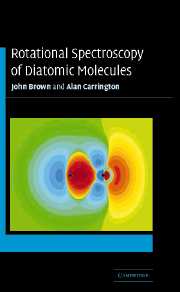Book contents
- Frontmatter
- Contents
- Preface
- Summary of notation
- Figure acknowledgements
- 1 General introduction
- 2 The separation of nuclear and electronic motion
- 3 The electronic Hamiltonian
- 4 Interactions arising from nuclear magnetic and electric moments
- 5 Angular momentum theory and spherical tensor algebra
- 6 Electronic and vibrational states
- 7 Derivation of the effective Hamiltonian
- 8 Molecular beam magnetic and electric resonance
- 9 Microwave and far-infrared magnetic resonance
- 10 Pure rotational spectroscopy
- 11 Double resonance spectroscopy
- General appendices
- Author index
- Subject index
- References
10 - Pure rotational spectroscopy
Published online by Cambridge University Press: 17 December 2010
- Frontmatter
- Contents
- Preface
- Summary of notation
- Figure acknowledgements
- 1 General introduction
- 2 The separation of nuclear and electronic motion
- 3 The electronic Hamiltonian
- 4 Interactions arising from nuclear magnetic and electric moments
- 5 Angular momentum theory and spherical tensor algebra
- 6 Electronic and vibrational states
- 7 Derivation of the effective Hamiltonian
- 8 Molecular beam magnetic and electric resonance
- 9 Microwave and far-infrared magnetic resonance
- 10 Pure rotational spectroscopy
- 11 Double resonance spectroscopy
- General appendices
- Author index
- Subject index
- References
Summary
Introduction and experimental methods
Simple absorption spectrograph
The first direct observations of pure rotational transitions induced by microwave or millimetre-wave radiation date from about 1945. Research during the Second World War, particularly on radiation sources in these wavelength regions, led to rapid developments in this branch of molecular spectroscopy. However, the observation of rotational structure in electronic and vibrational spectra, which had been routine for at least twenty years previously, meant that much was already understood about molecular rotations. Indeed most of the theory was developed in the years immediately following the birth of modern quantum mechanics. We have already described much of this theory in earlier chapters, and we will draw upon the results obtained in this chapter. We have also described molecular beam resonance and maser techniques for studying rotational spectra, but in this chapter we describe somewhat more conventional experiments in which the absorption of microwave radiation by molecules in the bulk gas phase is detected directly. As we will see, some ingenious techniques have been developed in more recent years to enable the study of short-lived transient species, neutral or charged free radicals. Molecular radio astronomy is also, in part, a branch of microwave absorption or emission spectroscopy, and we shall deal with that in subsection 10.1.6. We will also describe, in the next chapter, double resonance experiments in which microwave radiation is combined simultaneously with a second source of radiation of either similar or quite different wavelength.
- Type
- Chapter
- Information
- Rotational Spectroscopy of Diatomic Molecules , pp. 683 - 869Publisher: Cambridge University PressPrint publication year: 2003

